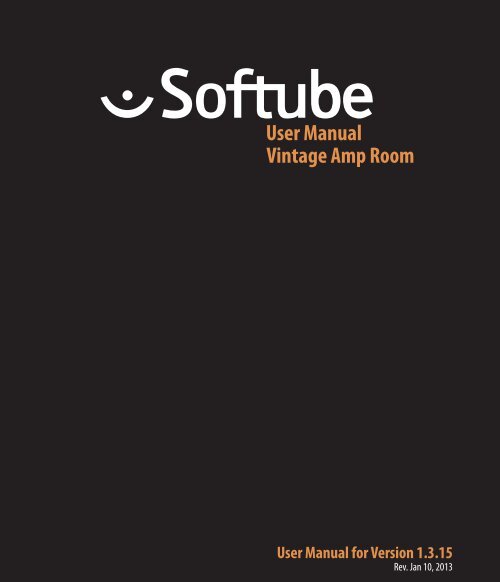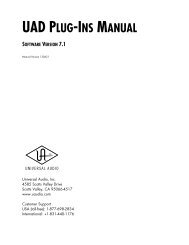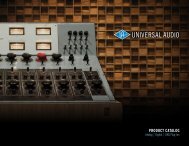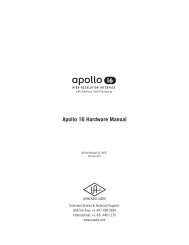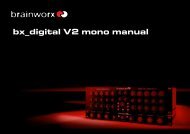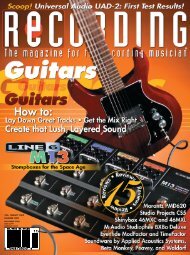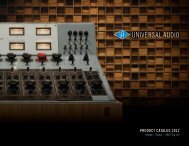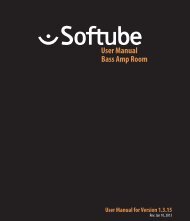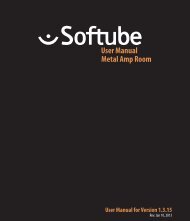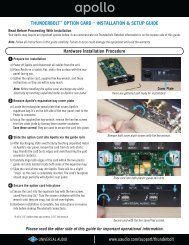Softube Vintage Amp Room Manual
Softube Vintage Amp Room Manual
Softube Vintage Amp Room Manual
Create successful ePaper yourself
Turn your PDF publications into a flip-book with our unique Google optimized e-Paper software.
User <strong>Manual</strong><br />
<strong>Vintage</strong> <strong>Amp</strong> <strong>Room</strong><br />
User <strong>Manual</strong> for Version 1.3.15<br />
Rev. Jan 10, 2013
<strong>Softube</strong> User <strong>Manual</strong><br />
© 2007-2013. <strong>Amp</strong> <strong>Room</strong> is a registered trademark of <strong>Softube</strong> AB, Sweden. <strong>Softube</strong> is a registered<br />
trademark of <strong>Softube</strong> AB, Sweden. All visual and aural references to the Valley People Dyna-mite, Trident<br />
A-Range, Tonelux and Tilt are trademarks being made with written permission from PMI Audio. The<br />
Tonelux and Tilt logo, the Valley People, Dyna-mite and associated logos, and the Trident, A-Range and<br />
Triangle logo are trademarks of PMI Audio Group, used under license. Tube -Tech is a registered trademark<br />
of Lydkraft ApS, Denmark. All specifications subject to change without notice. All Rights Reserved.<br />
Other company and product names mentioned herein are trademarks of their respective companies. Mention<br />
of third-party products is for informational purposes only and constitutes neither an endorsement<br />
nor a recommendation. <strong>Softube</strong> assumes no responsibility with regard to the performance or use of these<br />
products.<br />
<strong>Softube</strong> products are protected by patents SE526523 and SE525332, and related patents/patent applications,<br />
including WO06054943, US11/667360, US2004 0258250, EP1492081, EP1815459, and<br />
JP2004 183976.<br />
Your rights to the software are governed by the accompanying software license agreement (End User License<br />
Agreement).<br />
Disclaimer<br />
Every effort has been made to ensure that the information in this manual is accurate. However, there are a<br />
chance that we have made mistakes, and we hope that you understand that we are only humans. Please let<br />
us know about the mistake, and we’ll fix it in the mix (or in the next version of this manual).<br />
Support<br />
On the <strong>Softube</strong> website (www.softube.com) you will find answers to common questions (FAQ) and other<br />
topics that might interest you.<br />
Support questions can be posted at http://www.softube.com, where we will help you as fast as we can!<br />
Web: www.softube.com<br />
E-mail: info@softube.com<br />
Phone: +46 13 21 1623 (9 am – 5 pm CET)
SOFTUBE USER’S GUIDE | iii<br />
Contents<br />
1 User Interface 5<br />
Menu Row. . . . . . . . . . . . . . . . . . . . . . . 5<br />
Key Commands. . . . . . . . . . . . . . . . . . . . 6<br />
2 <strong>Vintage</strong> <strong>Amp</strong> <strong>Room</strong> 7<br />
Introduction . . . . . . . . . . . . . . . . . . . . . . 7<br />
User Interface. . . . . . . . . . . . . . . . . . . . . 8<br />
White <strong>Amp</strong> . . . . . . . . . . . . . . . . . . . . . 10<br />
Brown <strong>Amp</strong> . . . . . . . . . . . . . . . . . . . . . 11<br />
Green <strong>Amp</strong>. . . . . . . . . . . . . . . . . . . . . 13<br />
Bypassing <strong>Amp</strong>s or Cabs. . . . . . . . . . . . . . . 15<br />
Buying Recommendations. . . . . . . . . . . . . . 15<br />
Credits. . . . . . . . . . . . . . . . . . . . . . . 15
iv | Table of Contents
| 5<br />
1<br />
User Interface<br />
<strong>Softube</strong> plug-ins are “what you see is what you<br />
get” products. You should be able to intuitively learn<br />
the products within minutes, so that you can work<br />
fast and efficient with them. There are a couple of<br />
things that remain the same for all of our plug-ins,<br />
such as the menu row. These will be explained in<br />
this chapter. For detailed information of a particular<br />
plug-in, please see its chapter.<br />
Menu Row<br />
In the bottom of the plug-in interface, you will see<br />
a thin black row with some buttons. We’ll use the<br />
Dyna-mite plug-in as example, but the same goes<br />
for all plug-ins.<br />
About Box Opens the “About” Box with<br />
version info.<br />
Value Display Displays the knob value when<br />
the mouse is hovering over a<br />
control.<br />
Enable<br />
Enable Enable/Activate the plug-in.<br />
Set to off for bypass.<br />
Setup Changes global options for all<br />
instances of that plug-in.<br />
When the Enable switch is set to on (I), the plugin<br />
is active and will process audio. When set to off<br />
(0), it will be bypassed and not process any audio. It<br />
will take considerably less CPU when it is bypassed.<br />
“About” Box<br />
Value Display<br />
Enable<br />
Setup
6 | USER INTERFACE<br />
Setup<br />
In the Setup window you can change settings that<br />
will affect all instances of that particular plug-in. If<br />
you for example de-select the “Show Value Display”<br />
option in the Bass <strong>Amp</strong> <strong>Room</strong> plug-in the value<br />
display will be off for all Bass <strong>Amp</strong> <strong>Room</strong>s on your<br />
system until you select that option again.<br />
The different options vary between Windows and<br />
Mac, and also different formats and plug-ins. The<br />
most common options are:<br />
Show Value Display: Enables the parameter and<br />
value display in the bottom row of the plug-in.<br />
Reverse Mouse Wheel Direction: (Mac OS<br />
Only) Changes if the a knob is turned up or down<br />
when the mouse wheel is turned up or down. (Mac<br />
OS Only)<br />
You need to restart your host software (DAW) before the<br />
changes to fully take effect!<br />
If you messed something up and manually need to<br />
set these options, you’ll find them in text format in<br />
the following locations:<br />
Mac OS: ~/Library/Application Support/<br />
<strong>Softube</strong><br />
Windows: username\Application Data\<br />
Key Commands<br />
All numbers and labels in the plug-in are clickable.<br />
This allows you to easy select a setting by clicking<br />
on the wanted value. Hovering above a label will<br />
turn the mouse pointer into a pointing hand.<br />
Mouse<br />
Keyboard<br />
Up/Down or<br />
Mouse Wheel Change a parameter, such as a<br />
knob or a switch.<br />
Fine Adjust ⌘ (Mac) or Ctrl (Win),<br />
while changing the parameter<br />
value.<br />
Reset to Default Alt, while clicking on the<br />
knob or fader.<br />
Plug-In Specific Key Commands<br />
In many plug-ins, you can shift-click on a knob or<br />
a switch to get some extra functionality<br />
Metal <strong>Amp</strong> <strong>Room</strong><br />
Shift-click and drag a mic will move both mics<br />
simultaneously.<br />
All <strong>Amp</strong> <strong>Room</strong>s<br />
Shift-click in the cabinet background will change<br />
cabinet (or amp) without any animations
| 7<br />
2<br />
<strong>Vintage</strong> <strong>Amp</strong> <strong>Room</strong><br />
Introduction<br />
Straightforward and simple, <strong>Vintage</strong> <strong>Amp</strong><br />
<strong>Room</strong> emulates three great guitar amps in a complete<br />
studio set up with speaker cabinets and fully<br />
flexible microphone positioning. It’s easy to use for<br />
live performances and recordings, as well as for reamping<br />
and last minute tweaking.<br />
<strong>Amp</strong> <strong>Room</strong> has none of the added gadgets or<br />
weird sounding presets sometimes found in simulation<br />
software. Focusing on quality and accuracy, it<br />
simulates three amps, with sounds that are timeless<br />
and authentically raw. The goal is not to give you a<br />
pre produced, ultimate guitar sound, but to provide<br />
you with the ultimate tool to create your own.<br />
Because after all, only you know exactly what sound<br />
you want.<br />
Product Philosophy<br />
Everything about this product is authentic.<br />
The raw and dynamic sound is an absolute replica<br />
of what you would get if you had these amps set<br />
up in a real studio. What you see on the screen are<br />
photo realistic 3D renderings of the complete set ups,<br />
and you get to move an actual mic around when<br />
deciding which position is best, from near field<br />
off axis to far field and back, continuously, without<br />
preset positions.<br />
The idea is that using <strong>Amp</strong> <strong>Room</strong> should be<br />
like working directly with these amplifiers set up<br />
in a real studio, with a microphone in front of the<br />
cabinet, connected to your DAW. And we kept it<br />
simple. <strong>Amp</strong> <strong>Room</strong> has no knobs with dubious or<br />
unintuitive functionality, and no added gadgets or<br />
ridiculously fake sounding effects.
8 | VINTAGE AMP ROOM<br />
The sound of the amps has not been tampered with,<br />
because we don’t give you a pre produced, ultimate<br />
guitar sound. We simply provide you with the tools:<br />
three great, classic amplifiers, in digital form. Then<br />
it’s up to you to add compressors, EQs, reverb, or<br />
any other effects, to get the sound you want.<br />
In short, you need the same skills to master this<br />
software as you need when dealing with a real<br />
studio set up. You can get back to doing<br />
what you do best, because music production<br />
is about using your ears, not<br />
your computer skills.<br />
Supernormalize<br />
The “supernormalize” feature (from<br />
the beginning the internal name of a<br />
slightly magic component of our model<br />
building toolbox), makes sure that the<br />
output signal from <strong>Amp</strong> <strong>Room</strong> always<br />
has a reasonable volume. From a user<br />
perspective, this means that the <strong>Amp</strong><br />
<strong>Room</strong> never clips the signal (unwanted<br />
digital distortion). Also, the output<br />
volume is normalized, so even with<br />
low settings on the Volume knob in<br />
<strong>Amp</strong> <strong>Room</strong>, the output volume will<br />
be within a reasonable level and ready<br />
for digital recordings. Compare this to<br />
the real amp, which easily can have a<br />
dynamic range of 100 dB.<br />
real studio. Unfortunately, moving a mouse cursor<br />
on a 17” LCD screen isn’t exactly like grabbing the<br />
real mic stand in a cozy studio. Nevertheless, we<br />
have tried to imitate that feeling<br />
as far as it is possible, and if you have experience of<br />
working in real studios, you will notice that <strong>Amp</strong><br />
<strong>Room</strong> handles and sounds the way you expect it to<br />
do.<br />
<strong>Amp</strong> Panel<br />
<strong>Room</strong> View<br />
From a technical perspective, this<br />
means that the signal path within <strong>Amp</strong><br />
<strong>Room</strong> always has the highest dynamic<br />
range possible, and you won’t lose any<br />
bits on the way.<br />
User Interface<br />
Simplicity has been the goal when we<br />
developed this product; the amps and<br />
mics should work just as they do in the
SOFTUBE USER’S GUIDE | 9<br />
<strong>Amp</strong> Panel (Top Area)<br />
In the <strong>Amp</strong> Panel you can alter the settings of the<br />
amp by clicking the knob and dragging the mouse<br />
up and down. Switches will be switched either by<br />
clicking on them, or by click -and-dragging the<br />
mouse up and down.<br />
<strong>Room</strong> View (Bottom Area)<br />
In the <strong>Room</strong> View you can do two things, select<br />
one of the other amps or change the mic position.<br />
Mic Position<br />
When the mouse is located over<br />
the mic stand, the mouse pointer<br />
changes to an “up- down” arrow.<br />
Click and drag the mouse up or<br />
down to change the position of<br />
the mic stand. The microphone<br />
moves along a predetermined<br />
path, so you only need to move<br />
the mouse up or down, just as if<br />
you were changing a knob.<br />
<strong>Amp</strong> Selection<br />
You can change amp by clicking on the back ground<br />
and dragging the mouse to the left or right. The<br />
mouse pointer becomes a “left-right” arrow when<br />
you are pointing at the back ground to indicate that<br />
it is possible to change amplifier.
10 | VINTAGE AMP ROOM<br />
White <strong>Amp</strong><br />
White is based on an all round great amp, a classic that set the industry standard for classic, distorted<br />
rock’n’roll sounds. The genius is its simplicity. It’s stripped down to the bare essentials – all tubes, only one<br />
channel, and no reverb or any other built-in effects.<br />
Sound wise, it goes from mad screaming preamp shred, to warm, speakers about to break power amp distortion.<br />
Perfect when you need a charact eristically distorted edge and a powerful roar.<br />
First Use<br />
Set all parameters in the middle (12 o’clock). Turn down the Master Volume a little bit (to 10 o’clock) and<br />
play your guitar while changing the Pre <strong>Amp</strong> Volume. The sound goes from almost Hi Fi clean on low Pre<br />
<strong>Amp</strong> Volume settings, to a crunchy distortion (Pre <strong>Amp</strong> Volume in the middle), and finally to a high-gain<br />
setting with Pre <strong>Amp</strong> Volume on max. If you want an even meaner distortion, turn down the Middle and<br />
turn up the Master Volume.<br />
The sound will change quite dramatically when you start moving the mic away from the cabinet, since certain frequencies will<br />
cancel each other out due to interference between the four speaker drivers.<br />
Presence Bass Middle Treble<br />
Master<br />
Volume<br />
Pre-<strong>Amp</strong><br />
Volume<br />
Knobs<br />
The functionality of the knobs on the front panel of the plug in correspond exactly to the front panel of the<br />
real amplifier.<br />
Presence The presence is used to control the feedback loop and thus the amount of treble in the<br />
power amp. Turn it up to get a high frequency boost.
SOFTUBE USER’S GUIDE | 11<br />
Bass, Middle, and<br />
Treble These knobs are the tone control of the amplifier. This circuit is located after the<br />
preamp distortion and is used to shape the sound of the preamp distortion.<br />
Master Volume This knob controls the amount of power amplifier distortion. The power amp distortion<br />
is usually a little bit dirtier than the preamp distortion and gives a crunchier<br />
sound that sounds amazing for chords. Set the Pre <strong>Amp</strong> Volume to a low setting and<br />
turn up the Master Volume to the max to get that typical power amp distortion.<br />
Pre <strong>Amp</strong> Volume This knob controls the amount of preamplifier distortion, but since a high output from<br />
the preamplifier also makes the power stage distort, this also affects the power amplifier<br />
distortion. The preamp distortion is typically much “tighter” than the crunchy<br />
power amp distortion. To get a tight preamp distortion, you’ll have to turn down the<br />
Master Volume while maxing the Pre <strong>Amp</strong> Volume.<br />
Brown <strong>Amp</strong><br />
Brown is based on one of the most versatile classic amplifiers in music history. It’s been used in all kinds<br />
of genres, and with all kind of instruments, thanks to a sound that is clean, crisp and clear, but also warm,<br />
thick and punchy.<br />
Brown can produce anything from the clearest country style sound for steel guitars to a dirty, bluesy guitar<br />
sound. It works for both funky rhythms and mellow electric piano chords. It’s got a notoriously warm<br />
sound with a massive bass and a shimmering treble. Versatility embodied, it can do more or less whatever<br />
you want it to do. Except high gain heavy metal. And baking pizzas.<br />
First Use<br />
Set all knobs in the middle (at 12 o’clock). Set the microphone in a far field position (click the mic and drag<br />
the mouse downwards). Turn on the Vibrato and Bright switches. You should hear a bluesy sound with lots<br />
of room ambiance and a nice transition between distortion and a clean sound. Change the Volume to get<br />
more or less distortion and move the microphone closer to the cabinet to get a “tighter” sound with more<br />
bass frequencies.
12 | VINTAGE AMP ROOM<br />
Bright Volume Treble Middle Bass<br />
Vibrato<br />
On/Off<br />
Vibrato<br />
Speed<br />
Vibrato<br />
Intensity<br />
Knobs<br />
The functionality of the knobs on the front panel of the plug in corresponds to the front panel of the real<br />
amplifier, except the spring reverb, which hasn’t been included in this plug in. We have also added a “Vibrato”<br />
switch, which on the real amplifier is a foot switch. There is also a difference when all the tone controls<br />
are set at 0, see “Treble, Middle, and Bass” below.<br />
Volume This amplifier doesn’t have a Master Volume control, so the Volume knob controls<br />
both the preamplifier and power amplifier distortion.<br />
Bright Turn on this switch to get a high frequency boost. Works only at low to moderate<br />
Volume settings.<br />
Treble, Middle, and<br />
Bass These knobs are the tone control of the amplifier, but they also control the amount<br />
of distortion. If you, for example, have too much distortion in the bass frequencies,<br />
try turning down the Bass knob. (Electrically speaking, the tone controls are located<br />
before the preamp distortion.)<br />
The tone controls behave exactly like the real thing, except when all the controls are<br />
set fully counter clock wise. On the real amp, the amplifier would have become silent,<br />
as if you turned down the volume. A lot of reasons made us exclude this “feature,” so<br />
now when you turn the Treble, Middle and Bass knobs fully counter clock wise, that<br />
actually corresponds to the knobs being set to a little bit over nothing on the real amp.<br />
Vibrato, Speed and<br />
Intensity Turn on the vibrato (which is in fact a tremolo) by turning on the Vibrato switch. Use<br />
Speed to control the speed of the tremolo, and Intensity to control the amount of the<br />
tremolo effect.
SOFTUBE USER’S GUIDE | 13<br />
Green <strong>Amp</strong><br />
Green is packed with character and produces a<br />
pleasant guitar sound with warm yet intense poweramp<br />
distortion. Its edginess makes it shine through<br />
in mixes, without drowning out other instruments.<br />
Green is based on a famous brit pop amplifier<br />
from the middle of the 60’s. It has three different<br />
channels (“Vib Trem”, “Normal” and “Brilliant”)<br />
with two inputs each, and normally a guitar player<br />
will connect the guitar to the “Vib Trem” input and<br />
patch the signal to the other two channels. We have<br />
simulated the amplifier exactly this way; the guitar<br />
connected to the “Vib Trem” input and patched to<br />
the other two channels.<br />
To complicate things further, this amp doesn’t have<br />
a normal tone stack (EQ) but a single tone control<br />
which attenuates high frequencies when turned<br />
clock wise (different to what one would expect of<br />
a tone control). The previous owner of the original<br />
amp was so kind as to carve out “HI” and “LO” in<br />
the metal panel so that he would remember this.<br />
We have of course included this feature in <strong>Amp</strong><br />
<strong>Room</strong>.<br />
First Use<br />
Turn on the vibrato/tremolo effect (Vib-Trem<br />
Off-On) and select the tremolo effect (Vib-<br />
Trem Switch pointing at “Trem”). Set the<br />
Vib-Trem Volume knob in the middle position<br />
and all other knobs in the minimum position.<br />
Now adjust the Brilliant Volume to get a good<br />
balance between the tremolo effect and a clean<br />
sound.<br />
Vib/Trem<br />
Off/On<br />
Vib/Trem<br />
Speed<br />
Vib/Trem<br />
Switch<br />
Vib/Trem Ch.<br />
Volume<br />
Normal Ch.<br />
Volume<br />
Brilliant Ch.<br />
Volume<br />
Tone
14 | VINTAGE AMP ROOM<br />
Knobs<br />
The functionality of the knobs on the front panel of the plug in corresponds exactly to the front panel of the<br />
real amplifier, except that we have added the foot switch as a “Vib-Trem Off-On” switch.<br />
Vib-Trem Off-On Turn on the vibrato or tremolo effect by moving this switch clock wise.<br />
Vib-Trem Speed Three way switch that sets the speed of the vibrato or tremolo effect.<br />
Vib-Trem Switch Select between a vibrato and a tremolo effect. Unlike the makers of the Brown amp,<br />
the guys who built this amp actually knew the difference between a tremolo effect<br />
(amplitude modulation of a signal) and a vibrato effect (frequency modulation of a<br />
signal). Although this vibrato effect doesn’t sound anything like a real-world vibrato<br />
(opera singer style vibrato), it’s a lovely effect that gives the sound that special touch.<br />
Vib-Trem Volume Volume control of the Vib-Trem channel. This channel is basically the only one of the<br />
three channels that has any preamp distortion worth talking of.<br />
Normal Volume Volume control of the Normal channel. Except for the fuzz-like poweramp distortion<br />
on higher volume settings, this channel is very clean and doesn’t change the guitar<br />
sound so much.<br />
Brilliant Volume Volume control of the Brilliant channel, which has a much brighter sound than the<br />
Normal channel.<br />
Tone The Tone knob cuts high frequencies when it’s turned clock wise.<br />
Use the Vib-Trem Volume to get the distortion you want, and then use the Normal and Brilliant Volume as a bass<br />
and treble control. If you want a more fuzz-like distortion, use only the Normal and Brillant channel.
SOFTUBE USER’S GUIDE | 15<br />
Bypassing <strong>Amp</strong>s or Cabs<br />
You can choose to<br />
bypass the amp or the<br />
cabinet by selecting<br />
amp bypass or cab<br />
bypass from the small<br />
box in the lower right<br />
corner.<br />
This is very useful if you want to use <strong>Vintage</strong> <strong>Amp</strong><br />
<strong>Room</strong> with an external speaker (or speaker plug in)<br />
or if you just want to add a cabinet simulation to a<br />
track, such as a recorded line out from your amplifier.<br />
By bypassing the cabinets in <strong>Vintage</strong> <strong>Amp</strong> <strong>Room</strong>, you<br />
can use the cabinets from the other <strong>Amp</strong> <strong>Room</strong> plug ins.<br />
Just insert, for example, Bass <strong>Amp</strong> <strong>Room</strong> (with bypassed<br />
amplifier) on the track after <strong>Vintage</strong> <strong>Amp</strong> <strong>Room</strong> (with a<br />
bypassed cabinet).<br />
Buying Recommendations<br />
If you like the sound from <strong>Amp</strong> <strong>Room</strong> and would<br />
like to get that sound using the real deal (let’s face<br />
it, a real vintage amp is always sexier than a plug in),<br />
here are some buying recommendations.<br />
White<br />
If you like the sound of the White amp, we recommend<br />
you to buy a Marshall JCM800 2203 with a<br />
1960A 4x12” cabinet. Nothing beats the roar from a<br />
100W valve amp.<br />
Green<br />
Nothing beats the real stuff, and that quirky vibrato<br />
calls for a Vox AC30/6 Treble from the middle of<br />
the 60’s, perhaps suited with a pair of new Celestion<br />
Blue drivers.<br />
<strong>Room</strong><br />
And finally, if you like the sound of the room in<br />
which the cabinets we’re measured, you better call<br />
Soulmine Studios in Linköping and book some<br />
studio hours. Just tell them to set things up just as<br />
they did for the guys from <strong>Softube</strong>, and you’ll be<br />
fine from there...<br />
MARSHALL IS A TRADEMARK OF MARSHALL<br />
AMPLIFICATION PLC. FENDER IS A TRADEMARK<br />
OF FENDER MUSICAL INSTRUMENTS CORPO-<br />
RATION. VOX IS A TRADEMARK OF KORG (UK)<br />
LIMITED. CELESTION IS A REGISTERED TRADE-<br />
MARK OF KH TECHNOLOGY CORPORATION.<br />
Credits<br />
Oscar Öberg – concept, preamp modeling, sound<br />
and DSP-programming. Niklas Odelholm – cabinet<br />
and microphone modeling and sound design.<br />
Arvid Rosén – power amp modeling and sound<br />
programming. Torsten Gatu – interface and DSP<br />
programming. Per Connman – amp selection and<br />
modeling. Anders – graphics programming. Ulf<br />
Ekelöf – graphics programming and 3D rendering.<br />
Micko – 3D rendering. Papa Bear – collages and<br />
graphic profiling.<br />
Brown<br />
Likewise, if Brown is your favorite, we strongly recommend<br />
a 1966 Fender Twin Reverb combo with a<br />
2x12” cabinet.
<strong>Softube</strong> AB, S:t Larsgatan 10c, 582 24 Linköping, Sweden. www.softube.com


